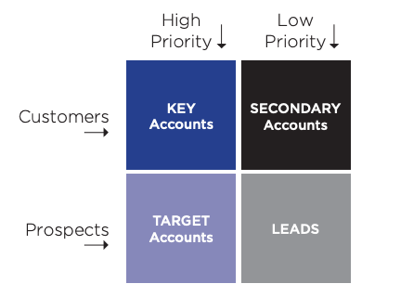 Top-performing sales organizations have many things in common. One is their understanding of and the importance they place on an account list management strategy. Here’s the concept and some tips used by world-class managers—feel free to use it in your organization.
Top-performing sales organizations have many things in common. One is their understanding of and the importance they place on an account list management strategy. Here’s the concept and some tips used by world-class managers—feel free to use it in your organization.

RELATED POST: What’s Your Account List Management Strategy?
A Winning Account List Management Strategy + Tips for Use
Key Accounts
Accounts for the top 25% of clients for a company or particular business unit. These clients represent a large percentage of overall revenue, often 70-80%. These are the ‘big accounts,’ and are naturally limited in number. The number of key accounts will vary by seller.
TIP:
Sellers should build a wall around their KEY accounts to keep competitors away. A great way to do this is to develop a KEY account growth plan for each KEY, and then execute elements of this plan on an ongoing basis.
Target Accounts
The very best prospects identified as the best match using the Target Business Profile filter (evaluate dollar potential, access, and fit). TARGET Accounts should be limited to less than 10 to allow sufficient focus. The appropriate number varies by situation, and in many cases as few as 3-4 may be most appropriate.
TIP:
Selecting TARGET accounts is extremely important. If sellers skip this step, they usually end up with prospects that do not convert to KEY account level, or at best spend very little money (see SECONDARY accounts).
A good method to determine if sellers are selecting quality TARGET accounts is to conduct an audit of the previous twelve months to evaluate:
- The number of TARGET to KEY conversions (should have at least 4)
- The percentage of TARGET to SECONDARY migration - this level should be lower than 25%. If the majority of TARGET accounts closed in a year, end up as SECONDARY accounts, it usually means the seller is not selecting quality TARGETS.
Secondary Accounts
The other 75% of clients for a company or individual business unit, that fall below the KEY level. As with Keys, the number of SECONDARY is naturally limited. SECONDARY accounts should get limited attention, but those thought to have KEY potential can be designated as TARGETS and focused on accordingly.
TIP:
Avoid the SECONDARY time suck at all costs. Sellers who spend too much time with SECONDARY accounts:
- Often neglect KEY accounts (this opens the door for competitors to poach them).
- And/or, they do not spend enough time converting TARGET to KEY accounts. The best sellers usually convert at least four TARGET to KEY level per year.
Leads
Prospects which are in the process of being qualified as potential TARGET using the Target Business Profile Filter (evaluate dollar potential, access to the decision maker and fit). LEADS can be prospects you want to research and develop as TARGETS in the near future. We recommend a maximum of 10 LEADS be assigned to any list at any one time.
TIP:
Keep in mind LEADS are the TARGET accounts of the future… not SECONDARY accounts of the future.
Implement this useful and practical concept with your team and utilize these tips to ensure the account list management strategy is beneficial to help improve sales performance.



